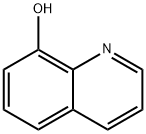A4743512
8-Hydroxyquinoline , ACS,99% , 148-24-3
Synonym(s):
8-Hydroxyquinoline;8-Oxychinolin;8-Quinolinol;Oxine;Oxine, 8-Quinolinol
CAS NO.:148-24-3
Empirical Formula: C9H7NO
Molecular Weight: 145.16
MDL number: MFCD00006807
EINECS: 205-711-1
| Pack Size | Price | Stock | Quantity |
| 50G | RMB126.40 | In Stock |
|
| 250G | RMB399.20 | In Stock |
|
| 1KG | RMB1272.00 | In Stock |
|
| others | Enquire |
Update time: 2022-07-08
PRODUCT Properties
| Melting point: | 70-73 °C(lit.) |
| Boiling point: | 267 °C752 mm Hg(lit.) |
| Density | 1.0340 |
| vapor pressure | 0.221Pa at 25℃ |
| refractive index | 1.4500 (estimate) |
| Flash point: | 267°C |
| storage temp. | Store below +30°C. |
| solubility | 0.56g/l |
| pka | 5.017(at 20℃) |
| form | Liquid |
| color | White to pale yellow or light beige |
| Water Solubility | INSOLUBLE |
| Sensitive | Light Sensitive |
| Merck | 14,4843 |
| BRN | 114512 |
| InChIKey | MCJGNVYPOGVAJF-UHFFFAOYSA-N |
| LogP | 1.85 at 25℃ |
| CAS DataBase Reference | 148-24-3(CAS DataBase Reference) |
| IARC | 3 (Vol. 13, Sup 7) 1987 |
| NIST Chemistry Reference | 8-Quinolinol(148-24-3) |
| EPA Substance Registry System | 8-Quinolinol (148-24-3) |
Description and Uses
8-Hydroxyquinoline has a wide variety of uses. Primarily because of their metal chelating properties, 8-hydroxyquinoline and its salts, halogenated derivatives, and metal complexes have been used as analytical reagents (Hollingshead, 1954) and as antimicrobial agents in medicine, fungicides, and insecticides (Harvey, 1975). It is also used as a preservative in cosmetics and tobacco, a chemical intermediate in dye synthesis (IARC, 1977), and a precipitating reagent for uranium and other radioactive metals in nuclear power plant liquid waste effluent. It is used in nuclear medicine with indium-111 (Davis et al., 1978).
Safety
| Symbol(GHS) |     GHS05,GHS06,GHS08,GHS09 |
| Signal word | Danger |
| Hazard statements | H301-H317-H318-H360D-H410 |
| Precautionary statements | P202-P273-P280-P301+P310-P302+P352-P305+P351+P338 |
| Hazard Codes | Xn,Xi |
| Risk Statements | 22-68-36/37/38 |
| Safety Statements | 45-36/37/39-26-36 |
| RIDADR | 2811 |
| WGK Germany | 3 |
| RTECS | VC4200000 |
| Hazard Note | Harmful/Irritant |
| TSCA | Yes |
| HazardClass | 9 |
| PackingGroup | III |
| HS Code | 29334990 |
| Hazardous Substances Data | 148-24-3(Hazardous Substances Data) |
| Toxicity | An LD50 value of 1,200mg/kg was reported for oral administration of 8-hydroxyquinoline to rats (straidsex unspecified; AAPCO, 1966);a value of 48 mg/kg was reported for intraperitoneal administration to mice (strain/sex unspecxed; Bernstein et al., 1963). |
| 発がん性評価について | IARC 3 |


